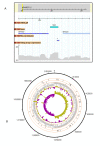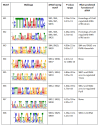Identification of novel non-coding small RNAs from Streptococcus pneumoniae TIGR4 using high-resolution genome tiling arrays
- PMID: 20525227
- PMCID: PMC2887815
- DOI: 10.1186/1471-2164-11-350
Identification of novel non-coding small RNAs from Streptococcus pneumoniae TIGR4 using high-resolution genome tiling arrays
Abstract
Background: The identification of non-coding transcripts in human, mouse, and Escherichia coli has revealed their widespread occurrence and functional importance in both eukaryotic and prokaryotic life. In prokaryotes, studies have shown that non-coding transcripts participate in a broad range of cellular functions like gene regulation, stress and virulence. However, very little is known about non-coding transcripts in Streptococcus pneumoniae (pneumococcus), an obligate human respiratory pathogen responsible for significant worldwide morbidity and mortality. Tiling microarrays enable genome wide mRNA profiling as well as identification of novel transcripts at a high-resolution.
Results: Here, we describe a high-resolution transcription map of the S. pneumoniae clinical isolate TIGR4 using genomic tiling arrays. Our results indicate that approximately 66% of the genome is expressed under our experimental conditions. We identified a total of 50 non-coding small RNAs (sRNAs) from the intergenic regions, of which 36 had no predicted function. Half of the identified sRNA sequences were found to be unique to S. pneumoniae genome. We identified eight overrepresented sequence motifs among sRNA sequences that correspond to sRNAs in different functional categories. Tiling arrays also identified approximately 202 operon structures in the genome.
Conclusions: In summary, the pneumococcal operon structures and novel sRNAs identified in this study enhance our understanding of the complexity and extent of the pneumococcal 'expressed' genome. Furthermore, the results of this study open up new avenues of research for understanding the complex RNA regulatory network governing S. pneumoniae physiology and virulence.
Figures




Similar articles
-
Redefining the Small Regulatory RNA Transcriptome in Streptococcus pneumoniae Serotype 2 Strain D39.J Bacteriol. 2019 Jun 21;201(14):e00764-18. doi: 10.1128/JB.00764-18. Print 2019 Jul 15. J Bacteriol. 2019. PMID: 30833353 Free PMC article.
-
Identification of 88 regulatory small RNAs in the TIGR4 strain of the human pathogen Streptococcus pneumoniae.RNA. 2012 Mar;18(3):530-46. doi: 10.1261/rna.027359.111. Epub 2012 Jan 24. RNA. 2012. PMID: 22274957 Free PMC article.
-
Identification of novel growth phase- and media-dependent small non-coding RNAs in Streptococcus pyogenes M49 using intergenic tiling arrays.BMC Genomics. 2012 Oct 13;13:550. doi: 10.1186/1471-2164-13-550. BMC Genomics. 2012. PMID: 23062031 Free PMC article.
-
Identification and Role of Regulatory Non-Coding RNAs in Listeria monocytogenes.Int J Mol Sci. 2011;12(8):5070-9. doi: 10.3390/ijms12085070. Epub 2011 Aug 10. Int J Mol Sci. 2011. PMID: 21954346 Free PMC article. Review.
-
How to find small non-coding RNAs in bacteria.Biol Chem. 2005 Dec;386(12):1219-38. doi: 10.1515/BC.2005.140. Biol Chem. 2005. PMID: 16336117 Review.
Cited by
-
The five homologous CiaR-controlled Ccn sRNAs of Streptococcus pneumoniae modulate Zn-resistance.PLoS Pathog. 2024 Oct 3;20(10):e1012165. doi: 10.1371/journal.ppat.1012165. eCollection 2024 Oct. PLoS Pathog. 2024. PMID: 39361718 Free PMC article.
-
Functional analysis of pneumococcal drug efflux pumps associates the MATE DinF transporter with quinolone susceptibility.Antimicrob Agents Chemother. 2013 Jan;57(1):248-53. doi: 10.1128/AAC.01298-12. Epub 2012 Oct 31. Antimicrob Agents Chemother. 2013. PMID: 23114782 Free PMC article.
-
Dual RNA-seq of pathogen and host.Nat Rev Microbiol. 2012 Sep;10(9):618-30. doi: 10.1038/nrmicro2852. Nat Rev Microbiol. 2012. PMID: 22890146 Review.
-
The Streptococcus suis transcriptional landscape reveals adaptation mechanisms in pig blood and cerebrospinal fluid.RNA. 2014 Jun;20(6):882-98. doi: 10.1261/rna.041822.113. Epub 2014 Apr 23. RNA. 2014. PMID: 24759092 Free PMC article.
-
The Mechanisms of Virulence Regulation by Small Noncoding RNAs in Low GC Gram-Positive Pathogens.Int J Mol Sci. 2015 Dec 14;16(12):29797-814. doi: 10.3390/ijms161226194. Int J Mol Sci. 2015. PMID: 26694351 Free PMC article. Review.
References
Publication types
MeSH terms
Substances
LinkOut - more resources
Full Text Sources
Molecular Biology Databases

